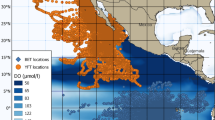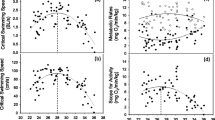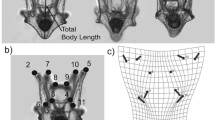Abstract
Diel swimming behaviors of juvenile anchovies (Anchoa spp.) were observed using stationary hydroacoustics and synoptic physicochemical and zooplankton profiles during four unique water quality scenarios in the Neuse River Estuary, NC, USA. Vertical distribution of fish was restricted to waters with DO greater than 2.5 mg O2 l−1, except when greater than 70% of the water column was hypoxic and a subset of fish were occupying water with 1 mg O2 l−1. We made the prediction that an individual fish would select a swim speed that would maximize net energy gain given the abundance and availability of prey in the normoxic waters. During the day, fish adopted swim speeds between 7 and 8.8 bl s−1 that were near the theoretical optimum speeds between 7.0 and 8.0 bl s−1. An exception was found during severe hypoxia, when fish were swimming at 60% above the optimum speed (observed speed = 10.6 bl s−1, expected = 6.4 bl s−1). The anchovy is a visual planktivore; therefore, we expected a diel activity pattern characteristic of a diurnal species, with quiescence at night to minimize energetic costs. Under stratified and hypoxic conditions with high fish density coupled with limited prey availability, anchovies sustained high swimming speeds at night. The sustained nighttime activity resulted in estimated daily energy expenditure over 20% greater than fish that adopted a diurnal activity pattern. We provide evidence that the sustained nighttime activity patterns are a result of foraging at night due to a lower ration achieved during the day. During severe hypoxic events, we also observed individual fish making brief forays into the hypoxic hypolimnion. These bottom waters generally contained higher prey (copepod) concentrations than the surface waters. The bay anchovy, a facultative particle forager, adopts a range of behaviors to compensate for the effects of increased conspecific density and reduced prey availability in the presence of stratification-induced hypoxia.










Similar content being viewed by others
References
Arrhenius F, Benneheij B, Rudstam LG, Boisclair D (2000) Can stationary bottom split-beam hydroacoustics be used to measure fish swimming speed in situ? Fish Res 45:31–41
Aubin-Horth A, Gingras J, Boisclair D (1999) Comparison of activity rates of 1+ yellow perch from populations of contrasting growth rates using underwater video observations. Can J Fish Aq Sci 56:1122–1132
Baird D, Ulanowicz RE (1989) The seasonal dynamics of the Chesapeake Bay ecosystem. Ecol Monogr 59:329–364
Batty RS, Blaxter JHS, Libby DA (1986) Herring (Clupea harengus) filter-feeding in the dark. Mar Biol 91:371–375
Bell GW, Eggleston DB (2005) Species-specific avoidance responses by blue crabs and fish to chronic and episodic hypoxia. Mar Biol 146:761–770
Bejda AJ, Phelan BA, Studholme AL (1992) The effect of dissolved oxygen on growth of young-of-year winter flounder, Pseudopleuronectes americanus. Environ Biol Fishes 34:321–327
Blaxter JHS (1964) Spectral sensitivity of the herring Clupea harengus. J Exp Biol 41:155–162
Blaxter JHS, Hunter JR (1982) The biology of the clupeoid fishes. Adv Mar Biol 20:1–223
Boisclair D, Leggett WC (1989) The importance of activity in bioenergetics models applied to actively foraging fishes. Can J Fish Aquat Sci 46:1859–1867
Borsuk ME, Stow CA, Luettich RA Jr, Paerl HW, Pinckney JL (2001) Modelling oxygen dynamics in an intermittently stratified estuary: estimation of process rates using field data. Estuar Coast Shelf Sci 52:33–49
Breitburg DL (1994) Behavioral-response of fish larvae to low dissolved-oxygen concentrations in a stratified water column. Mar Biol 120:615–625
Brett JR (1964) The respiratory metabolism and swimming performance of young Sockeye salmon. J Fish Res Board Can 21:1183–1226
Briggs CT, Post JR (1997) In situ activity metabolism of rainbow trout (Oncorhynchus mykiss): estimates obtained from telemetry of axial muscle electromyograms. Can J Fish Aquat Sci 54:859–866
Burton DT, Richardson LB, Moore CJ (1980) Effect of oxygen reduction rate and constant low dissolved oxygen concentrations on two estuarine fish. Trans Am Fish Soc 109:552–557
Buzzelli CP, Luettich Jr RA, Powers SP, Peterson CH, McNinch JE, Pinckney JL, Paerl HW (2002) Estimating the spatial extent of bottom-water hypoxia and habitat degradation in a shallow estuary. Mar Ecol Prog Ser 230:103–112
Crowder LB (1985) Optimal foraging and feeding mode shifts in fishes. Environ Biol Fishes 12:57–62
Decker MB, Breitburg DL, Marcus NH (2003) Geographical differences in behavioral responses to hypoxia: local adaptation to an anthropogenic stressor? Ecol Appl 13:1104–1109
Durbin EG, Durbin AG (1981) Standing stock and estimated production of phytoplankton and zooplankton in Narragansett Bay, RI. Estuaries 4:24–41
Eby LA, Crowder LB (2002) Hypoxia-based habitat compression in the Neuse River Estuary: context-dependent shifts in behavioral avoidance thresholds. Can J Fish Aquat Sci 59:952–965
Ehrenberg JE, Torkelson TC (1996) Application of dual-beam and split-beam target tracking in fisheries acoustics. ICES J Mar Sci 53:329–334
Essington TE (2003) Development and sensitivity analysis of bioenergetics models for skipjack tuna and albacore: a comparison of alternative life histories. Trans Am Fish Soc 132:759–770
Freon P, Misund OA (1999) Dynamics of pelagic fish distribution and behaviour: effects on fisheries and stock assessment. Fishing News Books, Oxford
Fry FEJ (1971) The effects of the environment on animal activity. In: Hoar WS, Randall DJ (eds) Fish physiology. Academic, New York, pp 1–98
Gibson RN, Ezzi IA (1985) Effect of particule concentration on filter- and particulate-feeding in the herring Clupea harengus. Mar Biol 88:109–116
Gibson RN, Ezzi IA (1990) Relative importance of prey size and concentration in determining the feeding behaviour of the herring Clupea harengus. Mar Biol 107:357–362
Gjelland KO, Bohn T, Knudsen FR, Amundsen P-A (2004) Influence of light on the swimming speed of coregonids in subarctic lakes. Ann Zool Fennici 41:137–146
Hanson PC, Johnson TB, Schindler DE, Kitchell JF (1997) Fish Bioenergetics 3.0 for Windows. University of Wisconsin Sea Grant Institute, Madison, WI
Hartman KJ, Brandt SB (1995) Trophic resource partitioning, diets, and growth of sympatric estuarine predators. Trans Am Fish Soc 124:520–537
Hastie T, Tibshirani R (1990) Generalized additive models. Chapman and Hall, New York
Helfman G (1993) Fish behavior by day, night and twilight. In: Pitcher TJ (ed) Behavior of teleost fishes. Chapman and Hall, New York
Hettler WF (1976) Influence of temperature and salinity on routine metabolic rate and growth of young Atlantic menhaden. J Fish Biol 8:55–65
Hinch SG, Rand PS (1998) Swim speeds and energy use of upriver-migrating sockeye salmon (Oncorhynchus nerka): role of local environment and fish characteristics. Can J Fish Aquat Sci 55:1821–1831
James AG, Probyn T (1989) The relationship between respiration rate, swimming speed, and feeding behaviour in the Cape anchovy Engraulis capensis Gilchrist. J Exp Mar Biol Ecol 131:81–100
Janssen J (1977) Will alewives (Alosa pseudoharengus) feed in the dark? Environ Biol Fishes 3:239–240
Johansson F, Leonardsson K (1998) Swimming speeds and activity levels of consumers at various resource and consumer densities under predation risk. Can J Zool 76:76–82
Johnson WS, Allen D, Ogburn MV, Stancyk SE (1990) Short-term predation responses of adult bay anchovies Anchoa mitchilli to estaurine plankton availability. Mar Ecol Prog Ser 64:55–68
Keister JE, Houde ED, Breitburg DL (2000) Effects of bottom-layer hypoxia on abundances and depth distributions of organisms in Patuxent River, Chesapeake Bay. Mar Ecol Prog Ser 205:43–59
Klebasko MJ (1991) Feeding ecology and daily ration of bay anchovy (Anchoa mitchilli) in the mid-Chesapeake Bay. MS Thesis. Marine Estuarine Environmental Sciences, Solomons, MD, 103 pp
Love RH (1977) Target strength of an individual fish at any aspect. J Acoust Soc Am 62:1397–1403
Luecke C, Teuscher D (1994) Habitat selection by lacustrine rainbow trout within gradients of temperature, oxygen, and food availability. Theory And Application Of Fish Feeding Ecology., Univ. South Carolina Press, Columbia, Sc 18:133–150
Luettich Jr RA, Carr SD, Reynolds-Fleming JV, Fulcher CW, McNinch JE (2002) Semi-diurnal seiching in a shallow, micro-tidal lagoonal estuary. Cont Shelf Res 22:1669–1681
Luo J, Musick JA (1991) Reproductive biology of the bay anchovy in Chesapeake Bay. Trans Am Fish Soc 120:701–710
Macy WK, Durbin AG, Durbin EG (1999) Metabolic rate in relation to temperature and swimming speed, and the cost of filter feeding in Atlantic menhaden, Brevoortia tyrannus. Fish Bull 97:282–293
McNatt RA, Rice JA (2004) Hypoxia-induced growth rate reduction in two juvenile estuary-dependent fishes. J Exp Mar Biol Ecol 311:147–156
MODMON (2004) Neuse River Estuary Modeling and Monitoring Program. http://www.marine.unc.edu/neuse/modmon/results/results.htm. Last accessed on 11 June 2004
Mulligan TJ, Chen DG (2000) Comment on “Can stationary bottom split-beam hydroacoustics be used to measure fish swimming speed in situ? by Arrhenius et al. Fish Res 49:93–96
Neill WH, Miller JM, Vanderveer HW, Winemiller KO (1994) Ecophysiology of marine fish recruitment—a conceptual-framework for understanding interannual variability. Neth J Sea Res 32:135–152
Paerl HW, Pinckney JL, Fear JM, Peierls BL (1998) Ecosystem responses to internal and watershed organic matter loading: Consequences for hypoxia in the eutrophying Neuse River Estuary, North Carolina, USA. Marine Ecology Progress Series 166:17–25
Paerl HW, Pinckney JL, Fear JM, Peierls BL (1999) Fish kills and bottom-water hypoxia in the Neuse River and Estuary: reply to Burkholder et al. Mar Ecol Prog Ser 186:307–309
Pedersen J (2001) Hydroacoustic measurement of swimming speed of North Sea saithe in the field. J Fish Biol 58:1073–1085
Pietrafesa L, Janowitz G, Chao T, Weisberg R, Askari F, Noble E (1986) The physical oceanography of Pamlico Sound. UNC Sea Grant Publication, UNC-SG-WP-86-5
Puckett KJ, Dill LM (1984) Cost of sustained and burst swimming to juvenile Coho salmon (Oncorhynchus kisutch). Can J Fish Aquat Sci 41:1546–1551
Rahel FJ, Nuntzman JW (1994) Foraging in a lethal environment: fish predation in hypoxic waters of a stratified lake. Ecology 75:1246–1253
Reebs SG (2002) Plasticity of diel and circadian activity rhythms in fishes. Rev Fish Biol Fish 12:349–371
Roman MR, Gauzens AL, Rhinehart WK, White JR (1993) Effects of low oxygen waters on Chesapeake Bay zooplankton. Limnol Oceanogr 38:1603–1614
Schael DM, Rice JA, Degan DJ (1995) Spatial and temporal distribution of threadfin shad in a southeastern reservoir. Trans Am Fish Soc 124:804–812
Scharf FS, Buckel JA, McGinn PA, Juanes F (2003) Vulnerability of marine forage fishes to piscivory: effects of prey behavior on susceptibility to attack and capture. J Exp Mar Biol Ecol 294:41–59
Shaw JJ, Tregenza T, Parker GA, Harvey IF (1995) Evolutionary stable foraging speeds in feeding scrambles: a model and an experimental test. Proc Roy Soc Lond Biol 260:273–277
Stanley DR, Nixon SW (1992) Stratification and bottom-water hypoxia in the Pamlico River Estuary. Estuaries 15:270–281
Stewart DJ, Weininger D, Rottiers DV, Edsall TA (1983) An energetics model for lake trout, Salvelinus namaycush: application to the Lake Michigan population. Can J Fish Aquat Sci 40:681–698
Taylor JC (2004) Distribution, behavior and trophic interactions of pelagic planktivores and copepods in an intermittently stratified estuary. Dissertation. Department of Zoology, Raleigh. 167 + ix pp
Taylor JC, Miller JM (2001) Physiological performance of juvenile southern flounder, Paralichthys lethostigma (Jordan and Gilbert, 1884), in chronic and episodic hypoxia. J Exp Mar Biol Ecol 258:195–214
Taylor JC, Rand PS (2003) Spatial overlap and distribution of anchovies (Anchoa spp.) and copepods in a shallow stratified estuary. Aquat Living Resour 16:191–196
Taylor JC, Rand PS (2007) Mesoscale distribution of juvenile anchovy grazing demand and prey availability in an intermittently hypoxic estuary. Mar Ecol Prog Ser (in review)
Thetmeyer H (1997) Diel rhythms of swimming activity and oxygen consumption in Gobiusculus flavescens (Fabricius) and Pomatoschistus minutus (Pallas) (Teleostei, Gobiidae). J Exp Mar Biol Ecol 218:187–198
Torgerson T, Kaartvedt S (2001) In situ swimming behavior of individual mesopelagic fish studied by split-beam echo target tracking. ICES J Mar Sci 58:346–354
Trudel M, Boisclair D (1996) Estimation of fish activity costs using underwater video cameras. J Fish Biol 48:40–53
USGS (2004) NWISWeb Data for North Carolina, Water Quality. http://waterdata.usgs.gov/nc/nwis/qw. Last accessed on 11 June 2004
Vazquez AV (1989) Energetics, trophic relationships and chemical composition of bay anchovy, Anchoa mitchilli in the Chesapeake Bay. MS Thesis. Marine-Estuarine Environmental Sciences, Solomons, MD. 165 pp
Videler J (1993) Fish swimming. Chapman and Hall, New York
Wakeman JM, Wohlschlag DE (1982) Least-cost swimming speeds and transportation costs in some pelagic estuarine fishes. Fish Res 1:117–127
Wardle CS, He P (1988) Burst swimming speeds of mackerel, Scomber scombrus L. J Fish Biol 32:471–478
Ware DM (1975) Growth, metabolism, and optimal swimming speed of a pelagic fish. J Fish Res Board Can 32:33–41
Ware DM (1978) Bioenergetics of pelagic fish: theoretical change in swimming speed and ration with body size. J Fish Res Board Can 35:220–228
Ware DM (1982) Power and evolutionary fitness of teleosts. Can J Fish Aquat Sci 39:3–13
Werner EE, Anholt BR (1993) Ecological consequences of the trade-off between growth and mortality rates mediated by foraging activity. Am Nat 142:242–272
Werner EE, Mittelbach GG, Hall DJ, Gilliam JF (1983) Experimental tests of optimal habitat use in fish: The role of relative habitat profitability. Ecology 64:1525–1539
Winberg GG (1956) Rate of metabolism and food requirements of fishes. Belorussian Univ., Minsk. 253 l. Fisheries Research Board of Canada Translation Service 164
Acknowledgments
We greatly appreciate the assistance of B. Balaszi, J. Chaves, C. Bergeron, B. Devoy, C. Yoder in the field. C. Bergeron and C. Yoder assisted with processing zooplankton samples in the laboratory and S. Johnston, K. Kumagai, and P. Nealson provided advice and assistance with hydroacoustic data analysis. The work benefited from discussions with L. Avens, B. Burke, J. Buckel, K. Craig, N. Reyns, S. Searcy, and J. Tuomikoski. This project was made possible by funding through an US EPA STAR Fellowship (U−913885) to JCT and a NOAA Sea Grant College Program grant to North Carolina Sea Grant at North Carolina State University (Grant no. R/MRD-44) to PSR.
Author information
Authors and Affiliations
Corresponding author
Additional information
Communicated by P.W. Sammarco.
Rights and permissions
About this article
Cite this article
Taylor, J.C., Rand, P.S. & Jenkins, J. Swimming behavior of juvenile anchovies (Anchoa spp.) in an episodically hypoxic estuary: implications for individual energetics and trophic dynamics. Mar Biol 152, 939–957 (2007). https://doi.org/10.1007/s00227-007-0745-6
Received:
Accepted:
Published:
Issue Date:
DOI: https://doi.org/10.1007/s00227-007-0745-6




